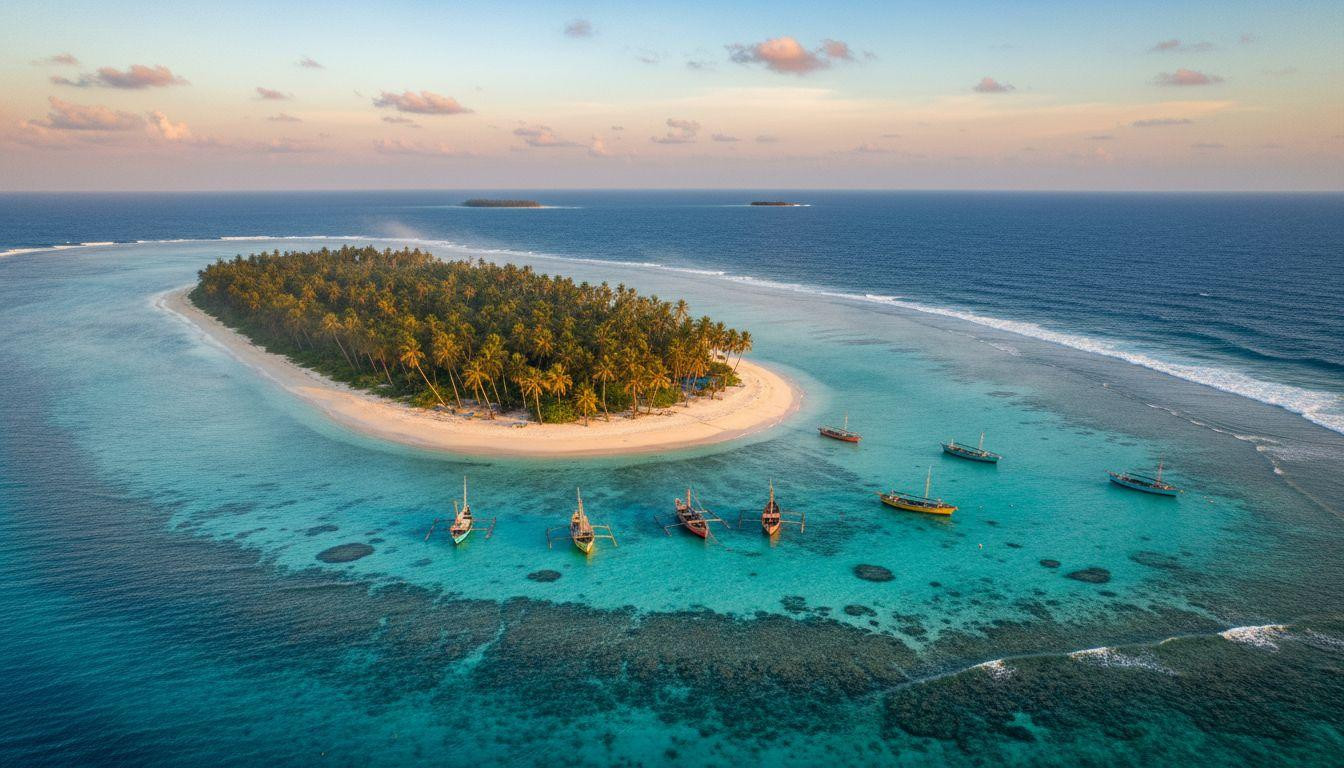Dawn breaks over Agatti Island at 6:47 AM, casting golden light across turquoise lagoons that stretch 2,600 square miles into the Arabian Sea. Steam rises from morning chai while traditional Jahadhoni boats rest silent against white coral sand. Just 70,000 residents inhabit these 36 coral islands scattered 125-275 miles off Kerala’s coast. While Goa welcomes 8 million annual tourists and the Maldives charges $500+ nightly, Lakshadweep’s permit system limits visitors to 18,500 yearly, preserving what few travelers witness: the Maldives’ visual poetry at fraction the cost, with authentic island culture intact.
The Arabian Sea’s forgotten atolls
Thirty-six islands scattered across impossible turquoise waters. Only 10 inhabited, most unreachable without government permits issued months in advance. The ferry from Kochi takes 14-20 hours, cutting through progressively clearer water as the mainland’s 1.4 billion inhabitants fade into memory.
A 90-minute flight to Agatti Island delivers visitors directly into lagoon country. Coral formations dating back millennia create natural barriers between shallow turquoise shallows and deep indigo channels. November marks the sweet spot: post-monsoon clarity, 79-86°F warmth, calm seas perfect for snorkeling.
The permit system ensures beaches remain empty even during peak winter months. Kavaratti, Kalpeni, Minicoy: names most Indians have never heard, protecting 2,600 square miles of coral ecosystems. This tiny island 25 miles from Port Blair offers similar turquoise serenity without the mainland crowds.
Where turquoise becomes a religion
Color gradients that defy photography
The lagoons shift from crystalline shallows where you count coral formations six feet below to turquoise mid-depths where parrotfish dart between brain coral. Finally bleeding into indigo channels where the reef drops away. White coral sand (naturally formed from pulverized coral and shells) creates beaches that glow under November’s softer light.
Bioluminescent dinoflagellates transform Bangaram’s shores after sunset into starlit seas. Each wave leaves trails of blue-green fire across wet sand, where turquoise shallows fade to indigo beyond wooden jetties.
The Jahadhoni tradition
Minicoy Island preserves wooden boat races unchanged for generations. Forty-foot crafts carved from coconut wood, their triangular sails catching Arabian Sea winds during annual festivals. Unlike tourism-manufactured traditions, these vessels remain working fishing boats between race seasons.
Families whose ancestors built identical designs 400 years ago crew these boats. The November 15-20 races draw islanders, not tourists. According to local fishermen, the tradition connects generations through maritime knowledge passed down through fathers and sons.
Island life at $90-150 daily
What authentic isolation costs
Government tourist huts: $12-30 nightly. Mid-range guesthouses on Kadmat: $60-145. Luxury Bangaram resort: $180-300. Meals average $2-4.50 at local eateries serving fresh reef fish, coconut-based curries, and Maldivian-influenced preparations unknown on the mainland.
Snorkeling trips: $6-12. Scuba diving to 40-foot depths: $25-60. The M.V. Kavaratti ship cruise (5 days visiting three islands with onboard accommodation) costs a fraction of Maldives equivalents. Remote beaches accessible only by sea remain pristine without resort development.
Beyond the resorts
Kavaratti’s lagoon offers kayaking through channels so clear the bottom looks touchable at 15 feet. Kalpeni’s storm beach extends like a white highway into turquoise nowhere. The 1885 British lighthouse on Minicoy provides 360-degree views across an atoll unchanged since colonial charts mapped these waters.
Traditional markets on Kavaratti unfold slowly at dawn. The scent of fresh fish and coconut, soft chatter of vendors, and ambient light create authentic sensory experiences impossible to manufacture. Local tourism officials emphasize sustainable practices that preserve coral ecosystems and island culture.
The Maldives’ quieter truth
The Maldives draws 1.7 million annual visitors to manufactured luxury at $500-2,000 nightly. Lakshadweep’s 18,500 permitted visitors discover what resort development erases: fishing villages where morning catch arrives in traditional boats, not motorized vessels. Mosques dating to Arab trading eras, not Instagram-optimized architecture.
Coral ecosystems protected by isolation rather than entrance fees tell the real story. The comparison isn’t perfect: Lakshadweep offers simpler infrastructure, stricter alcohol laws (prohibited on most islands), and genuine permit bureaucracy. But November’s empty beaches, $90 guesthouse stays, and bioluminescent shores reveal India’s best-kept tropical secret.
Affordable alternatives to luxury destinations exist worldwide, but few match Lakshadweep’s authentic preservation of island culture alongside natural beauty.
Your questions about Lakshadweep Islands, India answered
How do permits and access actually work?
Indian nationals obtain permits through registered tour operators or online government portals with 2-4 week processing. Foreign nationals face stricter restrictions, currently requiring Indian-organized tour packages with 60-90 day advance booking. Flights from Kochi to Agatti operate 1-2 times daily (90 minutes, $90-150 round-trip). Ships run 3-4 times weekly (14-20 hours, cheaper but rougher).
What about local culture and restrictions?
The predominantly Muslim population (96%+) follows conservative customs. Alcohol is prohibited on inhabited islands (available only at Bangaram resort). Conservative dress expected outside resort areas. Friday prayer times are observed, with shops closing briefly. The culture blends South Indian, Arab, and Maldivian influences through Malayalam-based language, traditional dance forms, and coconut-centric cuisine.
How does this compare to the Maldives experience?
Lakshadweep costs 60-70% less than Maldives while offering equal underwater visibility (25-30 meters). The trade-offs include simpler accommodations, permit bureaucracy, and cultural restrictions. However, the 18,500 annual visitors versus Maldives’ 1.7 million create genuinely uncrowded experiences. Plastic bans, regulated fishing, and protected coral reefs maintain ecosystem health that mass tourism often compromises.
The ferry departs Agatti at sunset, wake cutting turquoise into white foam as palm-fringed shores shrink into Arabian Sea vastness. Seventy thousand residents remain behind on their coral fortresses, guarding lagoons most Indians will never see. Tomorrow, Kochi’s crowds return. Tonight, bioluminescence writes temporary poetry across Bangaram’s forgotten beaches.
